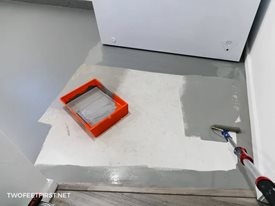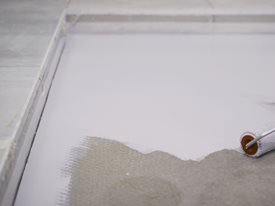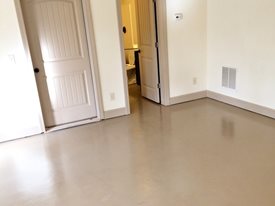WHAT TYPE OF PAINT CAN I USE ON CONCRETE FLOORS?
Always look for a paint formulated specifically for use on concrete floors. They are more durable than standard interior or exterior wall paints and can withstand a lot more abuse. Generally, you have two options to choose from: a water-based acrylic latex or an epoxy concrete coating. An acrylic latex concrete paint is easier to work with and is applied similarly to latex-based house paint. Although technically not a paint, an epoxy concrete coating will give you a similar look but requires you to mix the two-part epoxy formula before you can start painting. Epoxy coatings are not as easy to work with as paints, but they are longer lasting and will stand up to heavy traffic.
Learn more about choosing concrete paint.

Megan of TwoFeetFirst.net painted her concrete basement floors using an enamel porch and patio paint.
WHERE CAN I USE CONCRETE FLOOR PAINT?
Painted concrete floors can add flair to any room in the home and are easy to color match to your existing decor. Common applications include floors in basements, laundry rooms, living rooms, sunrooms, entryways, and garages. As long as the floor is in sound condition, it can be painted.
HOW DO I PREP A CONCRETE FLOOR FOR PAINTING?
The success of any painting project depends in large part on the condition of the surface you apply the paint to. When it comes to concrete floors, the surface needs to be thoroughly cleaned with a degreaser and water to remove all dirt and grime. If the concrete floor was previously covered by carpet or tile, you will also need to scrape off any remaining adhesive residue (see How to Remove Carpet Glue from Concrete Floors). After cleaning the floor, rinse it thoroughly and use a wet/dry vacuum to remove excess water.
CAN I PAINT A CONCRETE FLOOR THAT HAS CRACKS?
Yes, but you will probably need to repair them first. Concrete paints are great at hiding hairline cracks and other minor flaws in existing concrete, but larger cracks, gouges, or holes will need to be patched first with a concrete crack filler. Before repairing the crack, clean away any crumbling concrete using a wire brush and then vacuum away the debris. Apply the crack filler using a trowel or putty knife, smoothing away the excess. (Learn more about concrete crack repair.)
If the cracks in your floor are especially large and require extensive repair, you may be better off resurfacing the concrete with a decorative overlay rather than painting it.
HOW DO I APPLY CONCRETE FLOOR PAINT?
Painting a concrete floor is not much different than painting any other surface in your home. A few must-have supplies include painter’s tape to mask off walls and baseboards around the perimeter of the room, a paintbrush to fill in corners and edges, and a paint roller (along with an extension pole) to cover the remaining portion of the floor. But before you begin, be sure to carefully read the application instructions on the paint container and follow the manufacturer’s recommendations.
Some additional application tips:
- Some concrete paints require the application of a primer to ensure proper paint adhesion while others are self-priming and can be applied directly to bare concrete. If a primer is required, don’t skip this necessary step.
- Do a moisture test first. If you want your paint job to last, it needs to be applied to dry concrete. That’s because excess moisture in the floor could migrate to the surface and lift off the paint and even cause mold and mildew to form. Learn about some simple tests you can conduct for moisture-vapor transmission.
- Roll the paint onto the concrete floor surface evenly, rolling back over the paint to blend in any lines left by the edges of the roller. Generally, you’ll need to apply two coats for the best coverage, allowing the first coat to dry thoroughly before applying the next one.
- To prevent the buildup of fumes, open a window and run some fans to improve air circulation. This will also help to speed up the drying time.
DO I NEED TO SEAL A PAINTED FLOOR?
Applying a clear concrete sealer over a painted concrete floor isn’t necessary, but it will help to protect the paint from scratches, peeling, and abrasion. A concrete sealer will also give your floor a nice sheen and make it easier to clean. For the best results, apply a water-based sealer designed for interior use and make sure the product is compatible with the paint you are using. (Learn more about sealing concrete floors.)
IS PAINTING CONCRETE A DIY PROJECT?
In most cases, painting a concrete floor yourself is an easy job requiring minimal experience. But you may want to consider hiring a professional concrete contractor if your floor requires extensive surface preparation or you have a large project to tackle. Although using a professional will add significantly to the overall cost, it’s often worth the extra expense to make sure the job is done right. Keep in mind that if your DIY attempt fails, it can be very time consuming and labor intensive to strip paint from a concrete surface.
DESIGN IDEAS FOR PAINTED CONCRETE FLOORS
Most concrete floors will look amazing painted with one solid color. But if you want to give your painted floors more style and character, try some of these decorative enhancements. Most of these looks can be completed using simple tools such as decorative stencils, painter’s tape, and sponges.
- Apply a faux rug or decorative medallion to your floor using adhesive-backed stencils.
- Use painter’s tape to create checkerboard designs, chevron patterns, or borders.
- Apply a base layer of one paint color and then use a sponge or rag to randomly add contrasting colors.
- If you have artistic skills, get creative by painting freehand designs onto your floor. Or create a custom template by enlarging a design printed out on paper. See these examples of artistic concrete floors.
RELATED:
3 Longer-Lasting Alternatives to Concrete Floor Paint
Concrete Pool Deck Paint
9 Driveway Finishes That Are Better Than Paint


